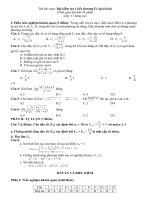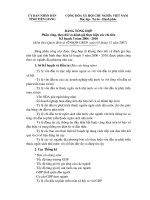Chemical Thermodynamics pptx
Bạn đang xem bản rút gọn của tài liệu. Xem và tải ngay bản đầy đủ của tài liệu tại đây (105.3 KB, 8 trang )
Chemical Thermodynamics
The scientific discipline that intersects the areas of chemistry and physic is commonly
known as physical chemistry, and it is in that area that a thorough study of
thermodynamics takes place. Physics concerns itself heavily with the mechanics of events
in nature. Certainly changes in energy however measured, whether it be heat, light,
work, etc. are clearly physical events that also have a chemical nature to them.
Thermodynamics is the study of energy changes accompanying physical and chemical
changes. The term itself clearly suggests what is happening "thermo", from
temperature, meaning energy, and "dynamics", which means the change over time.
Thermodynamics can be roughly encapsulated with these topics:
• Heat and Work
• Energy
• Enthalpy
• Entropy
• Gibbs Free Energy
Heat and Work
Heat and work are both forms of energy. They are also related forms, in that one can be
transformed into the other. Heat energy (such as steam engines) can be used to do work
(such as pushing a train down the track). Work can be transformed into heat, such as
might be experienced by rubbing your hands together to warm them up.
Work and heat can both be described using the same unit of measure. Sometimes the
calorie is the unit of measure, and refers to the amount of heat required to raise one (1)
gram of water one (1) degree Celsius. Heat energy is measured in kilocalories, or 1000
calories. Typically, we use the SI units of Joules (J) and kilojoules (kJ). One calorie of
heat is equivalent to 4.187 J. You will also encounter the term specific heat, the heat
required to raise one (1) gram of a material one (1) degree Celsius. Specific heat, given
by the symbol "C", is generally defined as:
C =
q
MΔT
Where:
C = specific heat in cal/g-°C
q = heat added in calories,
m = mass in grams
ΔT = rise in temperature of the material in °C.
The value of C for water is 1.00 cal/g-°C.
The values for specific heat that are reported in the literature are usually listed at a
specific pressure and/or volume, and you need to pay attention to these settings when
using values from textbooks in problems or computer models.
Example Problem: If a 2.34 g substance at 22°C with a specific heat of 3.88 cal/g-°C is
heated with 124 cal of energy, what is the new temperature of the substance?
Answer:
ΔT
=
q
MC
ΔT
=
(124)
(2.34)(3.88)
= 13.7°C
new T = 22 + 13.7 =
35.7°C
Two other common heat variables are the heat of fusion and the heat of vaporization.
Heat of fusion is the heat required to melt a substance at its melting temperature, while
the heat of vaporization is the heat required to evaporate the substance at its boiling point.
Chemical work is primarily related to that of expansion. In physics, work is defined as:
w = d × f
Where:
w = work, in joules (N×m) (or calories, but we are using primarily SI units)
d = distance in meters
f = opposing force in Newtons (kg*m/s
2
)
In chemical reactions, work is generally defined as :
w = distance × (area × pressure)
The value of distance times area is actually the volume. If we imagine a reaction taking
place in a container of some volume, we measure work by pressure times the change in
volume.
w = ΔV × P
Where:
ΔV is the change in volume, in liters
If ΔV=0, then no work is done.
Example Problem: Calculate the work that must be done at standard temperature and
pressure (STP is 0°C and 1 atm) to make room for the products of the octane combustion:
2 C
8
H
18
+ 25 O
2
> 16 CO
2
+ 18 H
2
O
Answer:
Knowing that 25 moles of gas are replaced by 34 moles of gas in this reaction, we can
calculate a net increase of 9 moles of gas. Knowing the molar volume of an ideal gas at
STP (22.4 L/mol), the change in volume and the work of expansion can be calculated
dV = 9 moles ∗ 22.4 L/mol = 202 L
The external pressure is 1.0 atm (standard pressure), so the work required is:
w = dV ∗ P = 202 L ∗ 1.00 atm = 202 l-atm
Using the conversion factor of 1 L-atm = 101 J, the amount of work in joules is:
w = 202 L-atm ∗ 101 j/L-atm = 2000 J, or 2kJ of energy
Energy
You might remember the first law of thermodynamics: energy cannot be created or
destroyed. Energy can only change form. Chemically, that usually means energy is
converted to work, energy in the form of heat moves from one place to another, or energy
is stored up in the constituent chemicals. You have seen how to calculate work. Heat is
defined as that energy that is transferred as a result of a temperature difference between a
system and its surroundings. Mathematically, we can look at the change in energy of a
system as being a function of both heat and work:
ΔE = q - w
Where:
ΔE is the change in internal energy of a system
q is the heat flowing into the system
w is the work being done by the system
If q is positive, we say that the reaction is endothermic, that is, heat flows into the
reaction from the outside surroundings. If q is negative, then the reaction is exothermic,
that is, heat is given off to the external surroundings.
You might also remember the terms kinetic energy and potential energy. Kinetic energy
is the energy of motion the amount of energy in an object that is moving. Potential
energy is stationary, stored energy. If you think of a ball sitting on the edge of a table, it
has potential energy in the energy possible if it falls off the table. Potential energy can be
transformed into kinetic energy if and when the ball actually rolls off the table and is in
motion. The total energy of the system is defined as the sum of kinetic and potential
energies.
In descriptions of the energy of a system, you will also see the phrase "state properties".
A state property is a quantity whose value is independent of the past history of the
substance. Typical state properties are altitude, pressure, volume, temperature, and
internal energy.
Enthalpy
Enthalpy is an interesting concept: it is defined by its change rather than a single entity. A
state property, the word enthalpy comes from the Greek "heat inside". If you have a
chemical system that undergoes some kind of change but has a fixed volume, the heat
output is equal to the change in internal energy (q = ΔE). We will define the enthalpy
change, ΔH, of a system as being equal to its heat output at constant pressure:
dH = q at constant pressure
Where:
ΔH = change in enthalpy
We define enthalpy itself as:
H = E + PV
Where:
H = enthalpy
E = energy of the system
PV = pressure in atm times volume in liters
You will not need to be able to calculate the enthalpy directly; in chemistry, we are only
interested in the change in enthalpy, or ΔH.
ΔH = H
final
- H
initial
or ΔH = H(products) - H(reactants)
Tables of enthalpies are generally given as ΔH values.
Example Problem: Calculate the ΔH value of the reaction:
HCl + NH
3
→ NH
4
Cl
(ΔH values for HCl is -92.30; NH
3
is -80.29; NH
4
Cl is -314.4)
Answer:
ΔH = ΔH
products
- ΔH
reactants
ΔH
products
= -314.4
ΔH
reactants
= -92.30 + (-80.29) = -172.59
ΔH = -314.4 - 172.59 = 141.8
We can also represent enthalpy change with the equation:
ΔH = ΔE + P ΔV
Where:
ΔV is the change in volume, in liters
P is the constant pressure
If you recall, work is defined as P ΔV, so enthalpy changes are simply a reflection of the
amount of energy change (energy going in or out, endothermic or exothermic), and the
amount of work being done by the reaction. For example, if ΔE = -100 kJ in a certain
combustion reaction, but 10 kJ of work needs to be done to make room for the products,
the change in enthalpy is:
ΔH = -100 kJ + 10 kJ = -90 kJ
This is an exothermic reaction (which is expected with combustion), and 90 kJ of energy
is released to the environment. Basically, you get warmer. Notice the convention used
here a negative value represents energy coming out of the system.
You can also determine ΔH for a reaction based on bond dissociation energies. Breaking
bonds requires energy while forming bonds releases energy. In a given equation, you
must determine what kinds of bonds are broken and what kind of bonds are formed. Use
this information to calculate the amount of energy used to break bonds and the amount
used to form bonds. If you subtract the amount to break bonds from the amount to form
bonds, you will have the ΔH for the reaction.
Example Problem: Calculate ΔH for the reaction:
N
2
+ 3H
2
→ 2NH
3
(The bond dissociation energy for N-N is 163 kJ/mol; H-H is 436 kJ/mol; N-H is 391
kJ/mol)
Answer:
ΔH = ΔH
products
- ΔH
reactants
To use the bond dissociation energies, we must determine how many bonds
are in the products and the reactants. In NH
3
there are 3 N-H bonds so in 2 NH
3
there are 6 N-H bonds. In N
2
there is 1 N-N bond and in 3H
2
there are 3 H-H bonds.
ΔH
products
= 6(391) = 2346
ΔH
reactants
= 163 + 3(436) = 1471
ΔH = 2346 - 1471 = 875
Entropy
Entropy is a measure of the disorder of a system. Take your room as an example. Left to
itself, your room will increase in entropy (i.e., get messier) if no work (cleaning up) is
done to contain the disorder. Work must be done to keep the entropy of the system low.
Entropy comes from the second law of thermodynamics, which states that all systems
tend to reach a state of equilibrium. The significance of entropy is that when a
spontaneous change occurs in a system, it will always be found that if the total entropy
change for everything involved is calculated, a positive value will be obtained. Simply,
all spontaneous changes in an isolated chemical system occur with an increase in entropy.
Entropy, like temperature, pressure, and enthalpy, is also a state property and is
represented in the literature by the symbol "S". Like enthalpy, you can calculate the
change of S (ΔS).
Δ S = S
final
- S
initial
or Δ S = S (products) - S (reactants)
Where:
ΔS is change in entropy
S
final
and S
initial
are the final and initial entropies, respectively
The following table shows the relationship between the state of a substance and its
entropy:
State of substance Relative Entropy (S)
gas highest S
aqueous high S
liquid medium S
solid lowest S
Gibbs Free Energy
The free energy of a system, represented by the letter "G", is defined as the energy of a
system that is free to do work at constant temperature and pressure. Mathematically, it is
defined as:
G = H - TS
Where:
G is the energy (sometimes called the free energy)
H is the enthalpy
T is the temperature
S is the entropy of the system.
You can also calculate the change in G the same way as you calculate the change in
enthalpy or entropy:
ΔG = G(products) - G(reactants)
Where:
ΔG is change in free energy
A pop-up calculator is available to calculate the enthalpy and Gibbs free energy changes
in reactions.
Given a constant temperature and pressure, the direction of any spontaneous change is
toward a lower Gibbs free energy. The graphic below shows that during a reaction, the
amount of free energy decreases until the reaction is at equilibrium. If the reaction goes
towards completion, the free energy minimum occurs very close to the pure products part
of the curve. In other words, the curve moves depending on the conditions of the reaction.
A table relating all of the state properties summarized above enthalpy change, entropy
change, and change in free energy is shown below. A spontaneous reaction is one that
occurs without any outside intervention. Processes that are spontaneous in one direction
are non-spontaneous in the reverse direction.
Enthalpy Change Entropy Change Spontaneous Reaction?
Exothermic (ΔH < 0) Increase (ΔS > 0) Yes, ΔG < 0
Exothermic (ΔH < 0) Decrease (ΔS < 0) Only at low temps, if |T ΔS| < |ΔH|
Endothermic (ΔH > 0) Increase (ΔS > 0) Only at high temps, if T ΔS > ΔH
Endothermic (ΔH > 0) Decrease (ΔS < 0) No, ΔG > 0
Enthalpy Practice Problem: Given the following bond dissociation energies (H-C is
413 kJ/mol; H-H is 436 kJ/mol; C=C is 614 kJ/mol; C-C is 348 kJ/mol), determine ΔH
for the reaction:
H
2
C=CH
2
(g) + H
2
(g) > H
3
C-CH
3
(g)
Enthalpy solution.
Entropy Practice Problem: Given the following entropy values Al
2
O
3
(s) is 51.00
kJ/mol; Al(s) is 28.32 kJ/mol; H
2
O(g) is 188.7 kJ/mol; H
2
(g) is 130.6 kJ/mol, determine
ΔS for the reaction:
Al
2
O
3
(s) + 3H
2
(g) > 2Al(s) + 3H
2
O(g)









